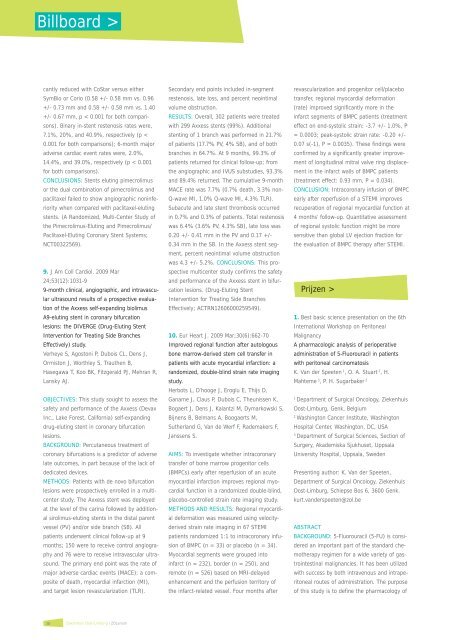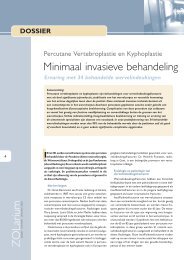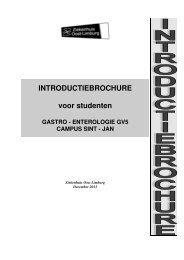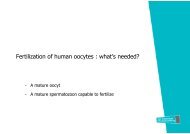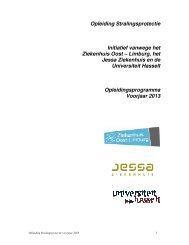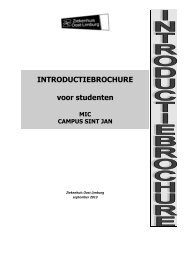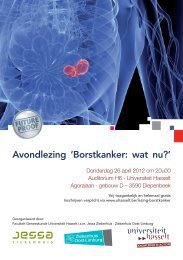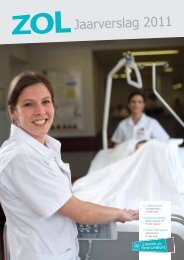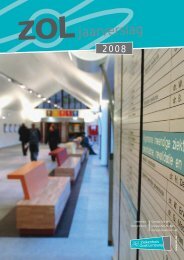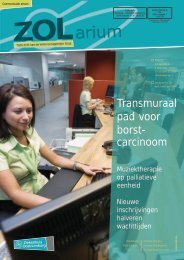Epiduroscopie - Ziekenhuis Oost-Limburg
Epiduroscopie - Ziekenhuis Oost-Limburg
Epiduroscopie - Ziekenhuis Oost-Limburg
You also want an ePaper? Increase the reach of your titles
YUMPU automatically turns print PDFs into web optimized ePapers that Google loves.
Billboard ><br />
cantly reduced with CoStar versus either<br />
SymBio or Corio (0.58 +/- 0.58 mm vs. 0.96<br />
+/- 0.73 mm and 0.58 +/- 0.58 mm vs. 1.40<br />
+/- 0.67 mm, p < 0.001 for both compari-<br />
sons). Binary in-stent restenosis rates were,<br />
7.1%, 20%, and 40.9%, respectively (p <<br />
0.001 for both comparisons); 6-month major<br />
adverse cardiac event rates were, 2.0%,<br />
14.4%, and 39.0%, respectively (p < 0.001<br />
for both comparisons).<br />
CONCLUSIONS: Stents eluting pimecrolimus<br />
or the dual combination of pimecrolimus and<br />
paclitaxel failed to show angiographic noninferiority<br />
when compared with paclitaxel-eluting<br />
stents. (A Randomized, Multi-Center Study of<br />
the Pimecrolimus-Eluting and Pimecrolimus/<br />
Paclitaxel-Eluting Coronary Stent Systems;<br />
NCT00322569).<br />
9. J Am Coll Cardiol. 2009 Mar<br />
24;53(12):1031-9<br />
9-month clinical, angiographic, and intravascular<br />
ultrasound results of a prospective evaluation<br />
of the Axxess self-expanding biolimus<br />
A9-eluting stent in coronary bifurcation<br />
lesions: the DIVERGE (Drug-Eluting Stent<br />
Intervention for Treating Side Branches<br />
Effectively) study.<br />
Verheye S, Agostoni P, Dubois CL, Dens J,<br />
Ormiston J, Worthley S, Trauthen B,<br />
Hasegawa T, Koo BK, Fitzgerald PJ, Mehran R,<br />
Lansky AJ.<br />
OBJECTIVES: This study sought to assess the<br />
safety and performance of the Axxess (Devax<br />
Inc., Lake Forest, California) self-expanding<br />
drug-eluting stent in coronary bifurcation<br />
lesions.<br />
BACKGROUND: Percutaneous treatment of<br />
coronary bifurcations is a predictor of adverse<br />
late outcomes, in part because of the lack of<br />
dedicated devices.<br />
METHODS: Patients with de novo bifurcation<br />
lesions were prospectively enrolled in a multicenter<br />
study. The Axxess stent was deployed<br />
at the level of the carina followed by additional<br />
sirolimus-eluting stents in the distal parent<br />
vessel (PV) and/or side branch (SB). All<br />
patients underwent clinical follow-up at 9<br />
months; 150 were to receive control angiography<br />
and 76 were to receive intravascular ultrasound.<br />
The primary end point was the rate of<br />
major adverse cardiac events (MACE): a composite<br />
of death, myocardial infarction (MI),<br />
and target lesion revascularization (TLR).<br />
38 <strong>Ziekenhuis</strong> <strong>Oost</strong>-<strong>Limburg</strong> I ZOLarium<br />
Secondary end points included in-segment<br />
restenosis, late loss, and percent neointimal<br />
volume obstruction.<br />
RESULTS: Overall, 302 patients were treated<br />
with 299 Axxess stents (99%). Additional<br />
stenting of 1 branch was performed in 21.7%<br />
of patients (17.7% PV, 4% SB), and of both<br />
branches in 64.7%. At 9 months, 99.3% of<br />
patients returned for clinical follow-up; from<br />
the angiographic and IVUS substudies, 93.3%<br />
and 89.4% returned. The cumulative 9-month<br />
MACE rate was 7.7% (0.7% death, 3.3% non-<br />
Q-wave MI, 1.0% Q-wave MI, 4.3% TLR).<br />
Subacute and late stent thrombosis occurred<br />
in 0.7% and 0.3% of patients. Total restenosis<br />
was 6.4% (3.6% PV, 4.3% SB), late loss was<br />
0.20 +/- 0.41 mm in the PV and 0.17 +/-<br />
0.34 mm in the SB. In the Axxess stent segment,<br />
percent neointimal volume obstruction<br />
was 4.3 +/- 5.2%. CONCLUSIONS: This prospective<br />
multicenter study confirms the safety<br />
and performance of the Axxess stent in bifurcation<br />
lesions. (Drug-Eluting Stent<br />
Intervention for Treating Side Branches<br />
Effectively; ACTRN12606000259549).<br />
10. Eur Heart J. 2009 Mar;30(6):662-70<br />
Improved regional function after autologous<br />
bone marrow-derived stem cell transfer in<br />
patients with acute myocardial infarction: a<br />
randomized, double-blind strain rate imaging<br />
study.<br />
Herbots L, D’hooge J, Eroglu E, Thijs D,<br />
Ganame J, Claus P, Dubois C, Theunissen K,<br />
Bogaert J, Dens J, Kalantzi M, Dymarkowski S,<br />
Bijnens B, Belmans A, Boogaerts M,<br />
Sutherland G, Van de Werf F, Rademakers F,<br />
Janssens S.<br />
AIMS: To investigate whether intracoronary<br />
transfer of bone marrow progenitor cells<br />
(BMPCs) early after reperfusion of an acute<br />
myocardial infarction improves regional myo-<br />
cardial function in a randomized double-blind,<br />
placebo-controlled strain rate imaging study.<br />
METHODS AND RESULTS: Regional myocardial<br />
deformation was measured using velocityderived<br />
strain rate imaging in 67 STEMI<br />
patients randomized 1:1 to intracoronary infusion<br />
of BMPC (n = 33) or placebo (n = 34).<br />
Myocardial segments were grouped into<br />
infarct (n = 232), border (n = 250), and<br />
remote (n = 526) based on MRI-delayed<br />
enhancement and the perfusion territory of<br />
the infarct-related vessel. Four months after<br />
revascularization and progenitor cell/placebo<br />
transfer, regional myocardial deformation<br />
(rate) improved significantly more in the<br />
infarct segments of BMPC patients (treatment<br />
effect on end-systolic strain: -3.7 +/- 1.0%, P<br />
= 0.0003; peak-systolic strain rate: -0.20 +/-<br />
0.07 s(-1), P = 0.0035). These findings were<br />
confirmed by a significantly greater improvement<br />
of longitudinal mitral valve ring displacement<br />
in the infarct walls of BMPC patients<br />
(treatment effect: 0.93 mm, P = 0.034).<br />
CONCLUSION: Intracoronary infusion of BMPC<br />
early after reperfusion of a STEMI improves<br />
recuperation of regional myocardial function at<br />
4 months’ follow-up. Quantitative assessment<br />
of regional systolic function might be more<br />
sensitive than global LV ejection fraction for<br />
the evaluation of BMPC therapy after STEMI.<br />
Prijzen ><br />
1. Best basic science presentation on the 6th<br />
International Workshop on Peritoneal<br />
Malignancy<br />
A pharmacologic analysis of perioperative<br />
administration of 5-Fluorouracil in patients<br />
with peritoneal carcinomatosis<br />
K. Van der Speeten 1 , O. A. Stuart 2 , H.<br />
Mahteme 3 , P. H. Sugarbaker 2<br />
1 Department of Surgical Oncology, <strong>Ziekenhuis</strong><br />
<strong>Oost</strong>-<strong>Limburg</strong>, Genk, Belgium<br />
2 Washington Cancer Institute, Washington<br />
Hospital Center, Washington, DC, USA<br />
3 Department of Surgical Sciences, Section of<br />
Surgery, Akademiska Sjukhuset, Uppsala<br />
University Hospital, Uppsala, Sweden<br />
Presenting author: K. Van der Speeten,<br />
Department of Surgical Oncology, <strong>Ziekenhuis</strong><br />
<strong>Oost</strong>-<strong>Limburg</strong>, Schiepse Bos 6, 3600 Genk.<br />
kurt.vanderspeeten@zol.be<br />
ABSTRACT<br />
BACKGROUND: 5-Fluorouracil (5-FU) is considered<br />
an important part of the standard chemotherapy<br />
regimen for a wide variety of gastrointestinal<br />
malignancies. It has been utilized<br />
with success by both intravenous and intraperitoneal<br />
routes of administration. The purpose<br />
of this study is to define the pharmacology of


